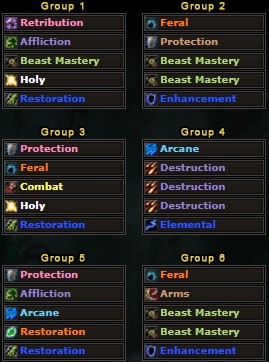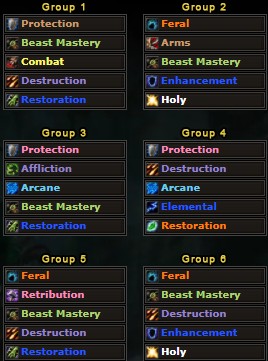Raid Composition Guide for TBC Classic
In TBC, most classes and specializations have unique buffs and debuffs that
can help their party (![]() Bloodlust) or even the whole raid
(
Bloodlust) or even the whole raid
(![]() Blessing of Salvation).
Blessing of Salvation).
This means that, besides individual class balance, you also need to take into account the buffs and debuffs each specialization brings in order to have a solid composition for all kinds of group content.
In this guide we will be going over what an optimized setup for 25-man raids looks like when using a 30-man roster, breaking the roster down into three 10-man groups and further into six 5-man groups, in order to showcase how to split your guild into leveling / dungeon / small raid groups.
25-man Raid Composition Advice Summary
You can find below a quick summary of our current recommendation for a 25-man raid, with swappable people for no-shows and specific fights in group 6:

This composition brings high DPS and has at least one of each class, making it easier to recruit for and gear.
10-man Raid Composition Advice Summary
Using the roster above as a baseline, we have created three optimized groups below: group 1 & group 2, group 3 & group 4, and group 5 & group 6. Take note that due to the tank and healer requirements, some players will have to swap specializations:

5-man Leveling or Dungeon Composition Advice Summary
With the initial raid roster as a baseline, you can either optimize for maximum group DPS or maximum group convenience which includes summons, crowd control options, and spreading out armor types to minimize wasting drops.
As making specific groups is mostly useful during the early rush to level up and get attuned, we will focus on convenience and loot-waste minimization with the group suggestions below:

Raid Composition Logic
The first thing to consider when assembling a good group setup is class balance among the three required roles: Tank, Healer and DPS. While every class and spec brings valuable utility of some sort, a single member of that specialization is usually enough to achieve maximum benefit for the whole group.
This leaves three specializations as the most desirable to stack, with benefits that continue to increase for each new member in the raid:
- Destruction Warlocks — the best caster DPS in TBC, scale very well with group
buffs, have no Mana issues, and buff each other with
 Improved Shadow Bolt.
They have some issues with threat, which can be mitigated through
Improved Shadow Bolt.
They have some issues with threat, which can be mitigated through  Soulshatter
and
Soulshatter
and  Blessing of Salvation.
Blessing of Salvation. - Beast Mastery Hunters, the strongest physical DPS in TBC, also scale exceptionally
with group buffs, provide their own in the form of
 Ferocious Inspiration,
and have no issues with threat due to much of their damage being split with their pet and
Ferocious Inspiration,
and have no issues with threat due to much of their damage being split with their pet and
 Feign Death.
Feign Death. - Shamans of any specialization, as all three bring valuable buffs and healing
on their own (
 Totem of Wrath,
Totem of Wrath,  Unleashed Rage,
Unleashed Rage,
 Mana Tide Totem) combined with
Mana Tide Totem) combined with  Bloodlust /
Bloodlust /
 Heroism for which you can always find a good use.
Heroism for which you can always find a good use.
Therefore, our setups will focus on stacking these specializations, while bringing as many other unique buffs from other classes and specs as possible.
If you are interested in learning more about the ups and downs of each class and specialization in TBC Classic, check the links below:
25-man Logic and Notes

Starting with the role setup, we want to have around 30 main raiders, split as follows:
- Between 2 and 6 Tanks, for subbing and small-group gameplay.
- Between 5 and 8 Healers, for tougher fights during progress.
- Between 14 and 18 DPS, which will fill the raid once tanks and healers are decided on a fight-by-fight basis.
Now, after doing the math, this would theoretically amount to a total of 32 raiders rather than 30 in a worst-case scenario, but it is virtually guaranteed that you will never need more than a handful of tanks for raids themselves; as such, the role numbers will be accounted by through respeccing when needed.
Tanks should be a mix of every class, as all of them have their benefits and are worth bringing at least one of. Feral tanks are the best to bring multiples of as they can double as a DPS when they are not tanking, making them very flexible off-tanks!
Healers should also include one of each class for gear optimization
purposes especially. Once you are looking to bring multiples of the same healer
class, look no further than the Restoration Shaman. Besides having the
best area-of-effect heal in the game, ![]() Chain Heal, they also bring
multiple utility totems for their group and
Chain Heal, they also bring
multiple utility totems for their group and ![]() Bloodlust
/
Bloodlust
/ ![]() Heroism — the best buff in the game especially if you are
doing in-combat swaps for your DPS groups.
Heroism — the best buff in the game especially if you are
doing in-combat swaps for your DPS groups.
DPS are all about Destruction Warlocks, and Beast Mastery Hunters, and their respective support. While we have tried to spread out the raid spots among as many classes as possible in the recommendation, ultimately the best DPS in TBC Classic for speedrunning comes from having as many groups looking like group 2 and group 4 as possible.
Feral Druids, Enhancement Shamans,
and Warriors are the best group-specific
physical DPS boosters, while Balance Druids and Elemental Shamans
are the best
for group-specific caster DPS-boosting. The rest of the raid spots are mostly
filled with specializations that bring strong raid-wide boosts, such as
![]() Expose Weakness from the Survival Hunter.
Expose Weakness from the Survival Hunter.
10-man Logic and Notes

10-mans are simple, role-wise. You want 2 Tanks, 2-3 Healers and 5-6 DPS for each raid. Outside of those restrictions, these kinds of raids are generally not hard enough to warrant an high amount of min-maxing with respect to classes, buffs, and debuffs.
That being said, since we provided a 30-man roster setup in the previous sections, it only makes sense to explain how to best split it apart into three 10-man groups in order to maximize gear and the odds of every group successfully clearing.
Our original roster contains enough classes to ensure full coverage of all crowd control requirements, a Shaman in each group, one blessing per player, and one optimized DPS group per raid.
Considering our role needs and the classes available, we would recommend that the Shadow Priest heals, possibly while maintaining Shadow spec in group 2 once the content is outgeared to turbo-charge the Warlocks even more. The Holy Paladin should tank for one of the groups to make area-of-effect pulls easy and the Balance Druid will tank for another to complete the 6 tanks, 6 healer requirements.
5-man Logic and Notes

5-mans are equally simple for roles; you want 1 Tank, 1 Healer and 3 DPS for each group.
Following the same logic as the 10-man groups and starting from the same setup, we rearranged the groups in order to make sure there is a Tank and a Healer in each, while ensuring the different armor types are as spread out as possible to minimize loot waste from unusable drops.
We also tried to keep groups focused on either physical or caster DPS and spread the melee around since some dungeons are very punishing to melee. Protection Paladins are always coupled with a Mage who can help them area-of-effect kite large pulls in dungeons and ensures infinite water if the need to drink in-between pulls for Mana arises.
Finally, by spreading the Warlocks around, every group except one has summons
and ![]() Create Healthstone, which is a huge convenience boost.
Create Healthstone, which is a huge convenience boost.
Changelog
- 13 Jan. 2022: Guide reviewed for Phase 3.
- 15 Jun. 2021: Guide added.
This guide has been written by Seksi, original Burning Crusade player and multi-class player, currently playing on Gehennas Horde. You can find him on the Classic Shaman (as Woah) and Druid Discords, as well as the Icy Veins Discord.
- One Month of Server-Renaming Rights Is on the Line in China’s PvP Event
- Group Finder and Dual Spec on Classic Era, Attunement and Arena Changes in TBC
- Burning Crusade Classic Anniversary Edition Pre-Patch Release Date and Character Transfers
- Titan Reforged’s 11 Phases Will Flip Classic Power Progression
- China’s Titan Reforged Realms Add Huge QoL Upgrades Western WoW Players Won’t See
- Armor Bonus Bug, Gold From old Expansions, and More: Mists of Pandaria Classic Hotfixes, October 31st
- New Challenge Mode Medal, Reworked Thunderforging: MoP Classic, The Thunder King PTR Development Notes, October 31st
- Hardcore WoW Just Got Much Harder With This New Game Mode